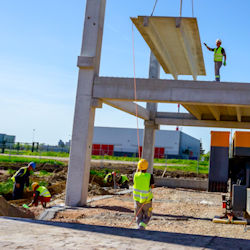SECTION 27 - CONCRETE, MASONRY, ROOFING AND RESIDENTIAL CONSTRUCTION
27.A General.
The fall protection threshold height requirement is 6 ft (1.8 m) for ALL work covered by this Section, unless specified differently below, whether performed by Government or Contractor work forces, to include residential (wood) construction and scaffolding work. > See Section 21.
27.A.01 Construction loads must not be placed on a structure or portion of a structure unless the employer determines, based on information from a person who is qualified in structural design, that the structure or portion of the structure is capable of supporting the loads.
27.A.02 Employees must not be permitted to work above or in positions exposed to protruding reinforcing steel, fasteners, or other impalement hazards unless provisions have been made to control the hazard.
27.A.03 Working under loads.
- No employee shall be permitted to work under concrete buckets, bundled material loads, or other suspended loads.
- Elevated concrete buckets and loads must be routed, to the extent practical, to minimize the exposure of workers to hazards associated with falling loads or materials from the loads. Vibrator crews must be kept out from under concrete buckets suspended from cranes of cableways.
- Riding on concrete buckets or other suspended loads must be prohibited.
27.A.04 Based on hazard evaluations conducted by supervisors, employers must identify and select, and each affected employee must use, personal protective equipment (PPE) and safety equipment that will provide appropriate protection for the work being performed. All PPE (i.e., for eyes, face, head and extremities, protective clothing, respiratory devices and protective shields and barriers) must be provided, used, and maintained in a sanitary and reliable condition whenever the hazard dictates. > See 29 CFR 1910.132.
Knowledge Check Choose the best answer for the question.
27-1. Who is responsible for determining if a structure or portion of the structure is capable of supporting loads.
You forgot to answer the question!

